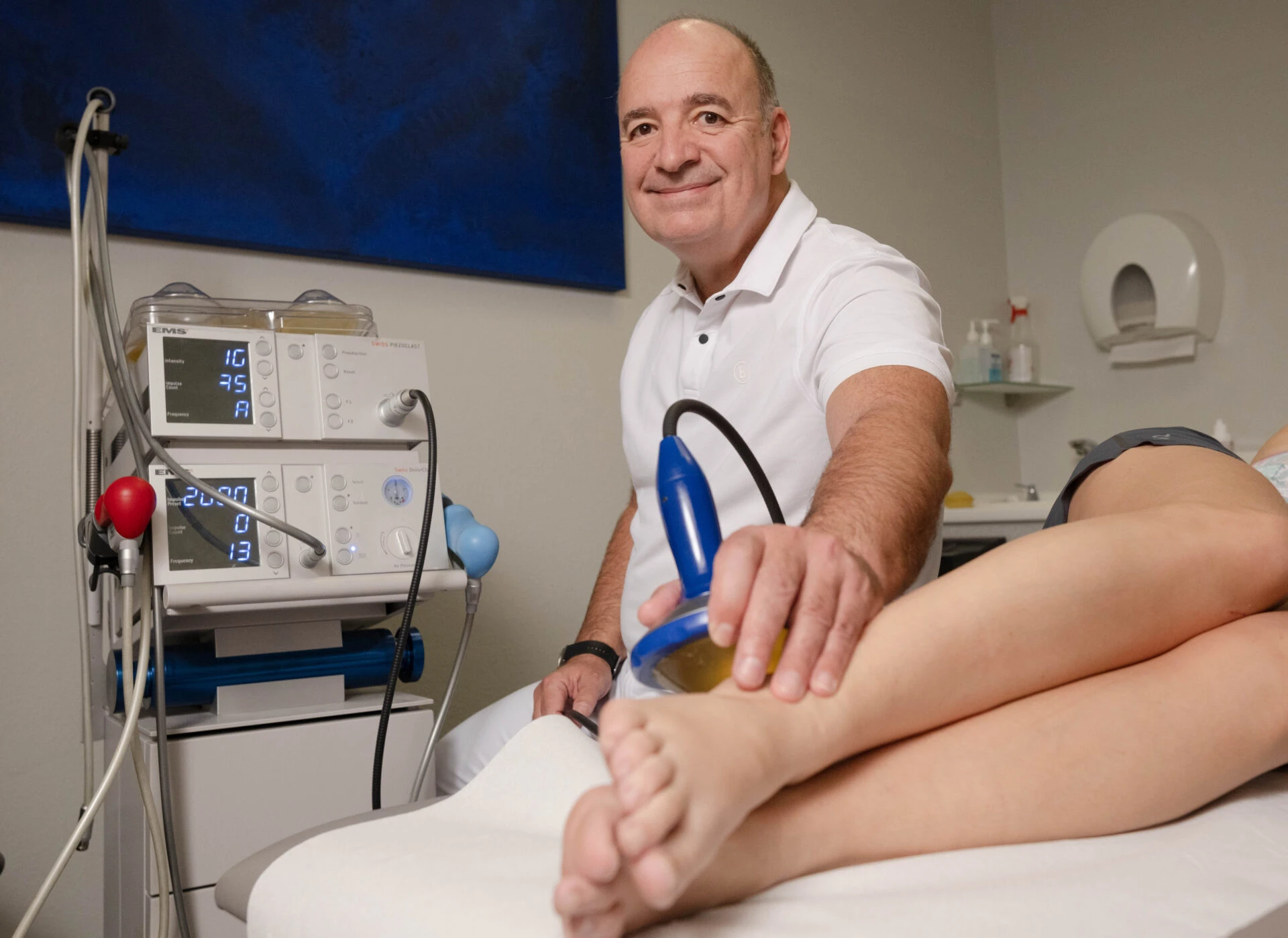What is shock wave therapy?
18. March 2025

Extracorporeal shock wave therapy (ESWT) is a non-invasive procedure that was originally developed to break up kidney stones. Today, it is widely used in the treatment of various musculoskeletal diseases.
In our practice, we use shock wave therapy in particular for disorders of tendon insertions (enthesiopathies), tendinosis calcarea, Achilles tendon enthesiopathies and elbow enthesiopathies.
Mechanism of action of shock wave therapy
Shock waves are mechanical-acoustic pressure pulses that are characterized by a rapid increase in pressure and a short pulse duration. In medical applications, these waves are generated using special devices and targeted at the affected areas of the body.
The shock waves penetrate the skin and soft tissue almost loss-free and only develop their effect in the deeper tissue.
The exact mechanisms of action of ESWT are not yet fully understood, but several effects have been identified:
- Stimulation of cell regeneration: The shock waves promote the formation of growth factors that support new tissue formation and regeneration.
- Pain relief: A reduction in neuronal pain transmission and a possible activation of gate control mechanisms in the spinal cord are assumed, which leads to pain relief.
- Improved blood circulation: Mechanical stimulation leads to improved microcirculation and increased metabolism in the treated tissue.
Fields of application of shock wave therapy
ESWT has proven to be effective for a variety of musculoskeletal disorders. The most common indications include
- Enthesiopathies: These are painful irritations of tendon insertions that can be caused by overloading or degenerative changes. Typical examples are tennis elbow (lateral epicondylitis) and golfer’s elbow (medial epicondylitis).
- Tendinosis calcarea: This condition is characterized by calcium deposits in the tendons, particularly in the rotator cuff of the shoulder. Shock wave therapy can help to reduce these calcifications and alleviate the pain.
- Achilles tendon enthesiopathies: Painful changes at the insertion of the Achilles tendon can be treated with ESWT to promote healing and reduce pain.
- Heel spur (plantar fasciitis): Shock wave therapy has proven to be effective for this common cause of heel pain and is covered by health insurance under certain conditions.
Evidence and studies
The effectiveness of shock wave therapy has been investigated in various studies, with varying results in some cases. For example, there is good evidence of the benefits of ESWT in the treatment of calcific shoulder pain and heel pain.
ESWT can also be an effective alternative treatment for bone healing disorders, particularly in the case of delayed bone healing. In view of the very low complication rate compared to the surgical procedure with comparable bone healing rates, ESWT should be considered as an alternative treatment for bone healing disorders.
We will be happy to advise you in our practice whether shock wave therapy is an option for treating your complaints.
Treatment procedure
A typical ESWT session lasts about 15 minutes. As a rule, several sessions are carried out at intervals of one to two weeks. There may be slight pain during the treatment, but this is usually well tolerated. Temporary pain or swelling may occur after the treatment, but this usually subsides quickly.
Risks and side effects
Shockwave therapy is considered safe and has few side effects. Possible side effects may include temporary reddening of the skin, swelling or bruising at the treated site. In rare cases, pain may occur during treatment.
Extracorporeal shock wave therapy offers an effective and gentle treatment option for various musculoskeletal disorders. However, it is not suitable for all patients.
The following contraindications should be noted:
- Pregnancy: Safety studies are lacking, therefore treatment is not recommended.
- Blood clotting disorders or taking blood-thinning medication: increased risk of hematomas or bleeding.
- Acute infections or inflammations in the treatment area.
- Tumor diseases in the treated area: risk of undesired cell stimulation.
- Open wounds or fresh injuries to the affected area.
Conclusion
Shock wave therapy (ESWT) has proven to be an effective, non-invasive method for treating various musculoskeletal complaints. It can relieve pain, promote healing and support tissue regeneration.
Thanks to its targeted effect on cell regeneration, blood circulation and pain perception, it offers a promising alternative to invasive procedures or lengthy drug treatments.
Do you suffer from chronic pain or tendon problems? In our practice, we use shock wave therapy specifically to treat your complaints.
Make an appointment now and let us advise you!